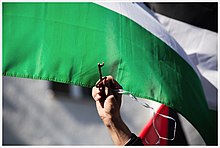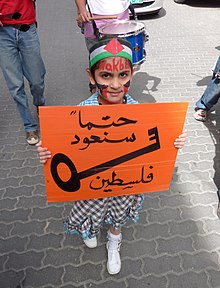The Palestinian key is the Palestinian symbol of their homes lost in the Nakba, when more than half of the population of Mandatory Palestine was either expelled or fled violence in the 1948 Palestinian exodus and subsequently refused the right to return. Almost 75 years later the key remains a potent symbol and reminder of physical and emotional loss and injustice.[1][2]
It is considered part of a hope for return and a claim to the lost properties.[3]
The keys are large and old-fashioned in style. Enlarged replicas are often found around Palestinian refugee camps, and used at pro-Palestinian demonstrations around the world as collective symbols.[3]
Gallery[edit]
Entrance to the Aida refugee camp, near Bethlehem
Palestinian art to symbolize United Nations General Assembly Resolution 194
A key as part of the Arabic word for "Peace" as West Bank Wall graffiti art
Outside Jericho, with the words "We will return..."
See also[edit]
References[edit]
- ^ Meital, Y.; Rayman, P. (2017). Recognition as Key for Reconciliation: Israel, Palestine, and Beyond. Social, Economic and Political Studies of the Middle East and Asia. Brill. ISBN 978-90-04-35580-4.
Michal concedes the fact that Israelis do the same thing to the memory of the Nakba when saying "it was in 1948, enough talking about the past, let's talk about the future." When the Palestinians come with their keys [the Palestinian symbol of their lost homes], she says, "it's the same thing, it's a memory still burning in the hearts of families
- ^ Fisk, Robert (2018-06-28). "'I spoke to Palestinians who still hold the keys to homes they fled decades ago – many are still determined to return'". The Independent.
Keys must always be the symbol of the Palestinian "Nakba" – the "disaster" – the final, fateful, terrible last turning in the lock of those front doors as 750,000 Arab men, women and children fled or were thrown out of their homes in what was to become the state of Israel in 1947 and 1948.
- ^ a b Feldman, llana. 2008. Refusing Invisibility: Documentation and Memorialization in Palestinian Refugee Claims, Journal of Refugee Studies 21 (4): 4, page 503: "Anyone familiar with Palestinian visibility practices will certainly be aware of the importance of certain central objects within this field. Many refugees still have the keys to their houses in Palestine. Keeping these keys, and showing them to visitors and researchers, is part of a hope for return and a claim to these properties. Given this widespread practice, these keys, with their distinctive old-fashioned look, have also become symbols of refugee commitment to Palestine. At demonstrations in support of Palestinians one can often find people carrying enlarged replicas of these keys—in the process transforming individual objects into collective symbols."





